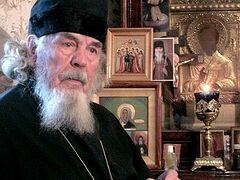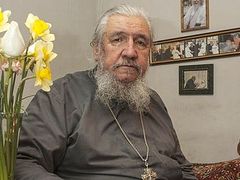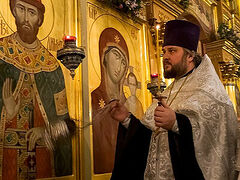We met with Natalia Ivanovna at the Holy Trinity-St. Sergius Lavra in the evening after the Vigil at the end of the summer feast of St. Sergius of Radonezh. Natalia Ivanovna and her son Nikolai Igorevich were walking along the Lavra after leaving the Holy Trinity Cathedral. We too left the cathedral, where at the end of the service everyone who had venerated the reliquary with the relics of St. Sergius was handed a flower by a monk. Each of us was given a red rose: this is how St. Sergius finished his annual summer celebration.
Moving away from the relics, the parishioners were filled with spiritual joy and gratitude to God and His saint for being vouchsafed to visit this holy place on the feast of its founder.
We met and talked with Natalia Ivanovna quite by chance, and during the conversation we realized that we had something to talk about in the future. I invited her to the radio to record our talk.
—Natalia Ivanovna, could you share some of your memories of past times? Could you tell our readers about yourself, your youth, the churches you attended and the life of the Church in your time?
—I was a parishioner of the church in Trubnaya Street, and as a girl I went to school there near the church. This is in Kolokolnikov Lane. Later that church was demolished, and we were transferred to another school, opposite the market. I forgot what that lane is called. After I had finished seventh grade, the Great Patriotic War [part of WWII: in the USSR from June 22, 1941, till May 9, 1945.—Trans.] broke out. And I had to go to work.
I was not yet seventeen years old—I was sixteen and had just gotten my passport. And I started to work because young people began to be sent to the labor front.
My mother (now reposed) raised me alone. My father died early, when I was five. We lived in a tiny room in a space of seven square meters (c. 75 square feet), in the former monastic baths of the Convent of the Nativity of the Mother of God. My dear mother was very religious, and I was an ordinary school girl. There were no churches that we could attend. The church in Kolokolnikov Lane was pulled down, and a school was built there, in which, as I said, I studied.
We began to attend the Greek church between Trubnaya Square and the Petrovsky Gate—on the left side. This Greek church still exists. As far as I remember, two very good Greeks served there, and sometimes I even pray for their repose—their names are Archpriest Constantine and Archpriest John. Very good, tall and handsome; they had a rich diction.
I loved listening to priests who had a good diction—it was just nice to listen to them. These are the churches we attended.
My dear mother took us by the hand. Apart from me, there were also my cousin, two nieces and a nephew. The nephew was probably seven or eight years old. One day a car drove out from behind the gate and almost knocked him down as he had broken away. And after that incident we stopped going to that church.
My dear mother suffered two heart attacks and twice had jaundice; she was very sickly, so she stopped going to church. And we too stopped going to that church in order not to torment her. And we had no other churches locally.
And before that, we would take delight in going to church and receiving Communion, so no persecutions affected us, thank God!
I was even surprised when, for example, I heard the following words: “Here is an unbaptized child.” I would say: “How is it that he is unbaptized? Let’s go and arrange it with the priest who will christen him—and that’s all! If not in the daytime, then in the evening.” We didn’t have any difficulties with this, thank God.
 The Church of the Prophet Elias in Obydensky Lane. The 1940s And then all the churches were closed here. Only the very nice church of St. Elias in Obydensky Lane Was left on Kropotkinskaya Square [since 1993: Prechistenskiye Vorota Square.—Trans.], opposite the Cathedral of Christ the Savior, across a side street. We started to attend it.
The Church of the Prophet Elias in Obydensky Lane. The 1940s And then all the churches were closed here. Only the very nice church of St. Elias in Obydensky Lane Was left on Kropotkinskaya Square [since 1993: Prechistenskiye Vorota Square.—Trans.], opposite the Cathedral of Christ the Savior, across a side street. We started to attend it.
I remember that my mother brought me there when I was ten. She would take me by the hand; then children were different—now they run around as if berserk. And we all walked hand in hand.
—Natalia Ivanovna, who was the rector of the Church of the Prophet Elias in Obydensky Lane at that time?
—Archpriest Alexander Tolgsky (1880-1962). We remember him well. He had previously served in Bogorodsk.
There were two brothers: Archpriest Nikolai Tolgsky1 and Archpriest Alexander Tolgsky. Archpriest Nikolai served at the church in Kolokolnikov Lane, he was the rector too. But he was soon removed and exiled, and we knew nothing more about his fate. Father Nikolai was young and handsome, and father Alexander was older than him.
And from the day we had crossed the threshold of St. Elias Church in Obydensky Lane we went there until we settled next to the Church of holy Martyr Tryphon. We went only there on Pascha, Pentecost, during the fasts, and to hear the Canon of St. Andrew of Crete...
Initially, tram no.17 went there from Trubnaya Square to Kropotkinskaya Square, and then a trolleybus began to run there. It was even better for us, we were just lucky.
My dear mother stayed at home because she was already terribly ill. But we began to travel on our own.
I had a sister who was five years my senior; now she is dead. And I also had two cousins; now both are gone. I am the only one still living.
St. Elias Church was filled mainly with intellectual parishioners. At first it was located in the center, near Arbat Street. By the way, there was no church at the Nikitsky Gate. You see, the church where Alexander Pushkin got married was closed as well. Therefore, all Orthodox intellectuals began to attend St. Elias Church in Obydensky Lane. There were always a lot of people in this church.
Fr. Alexander Tolgsky was a very good priest. He was an archpriest with two crosses, and a widower. He lost his wife Catherine early. She was buried at the German cemetery. And he lived most of his life as a widower. He had an assistant who sometimes came to him, helped him with the housework and cooked him food.
He died as a very old man: I think he lived till the age of eighty-two. Earlier I had already buried my mother: her coffin was in this church. And I remember Fr. Alexander coming to serve the funeral for her when he had a thirty-nine degree fever. Then smallpox was raging among adults in Moscow. And we came to receive the blessing to place the coffin with my mother’s body inside the church (she died shortly before her seventy-eighth birthday).
I remember waking up and hearing my dear mother shout: “Natulya [a diminutive form of the name Natalia.—Trans.], get up! Go to church!”
I worked from the age of sixteen: they took young people to the labor front, and my cousin worked at a knitwear factory. That factory was then located behind the Hermitage Garden, and she worked there as a secretary. One day she came home and said to my dear mother: “Aunt Lena, let’s fix the girls (I also had a cousin named Lyalya and a niece named Tosya) up with a factory job—they are just hiring students now.” We discussed it with another cousin, and my mother agreed: “Go ahead! Otherwise they will be driven to the labor front! But now they will be busy.”
There were ten-hour night shifts at the factory where I worked. There were a winding shop and a polka rib shop. Woolen yarn and plain yarn were wound. Plain yarn was used for puttees for the military, and woolen—for sweaters for the highest military ranks. And at the polka rib shop we knitted puttees and yarn.
I became friends with Tanechka [a diminutive form of the name Tatiana.—Trans.] there; she was one year my senior and had already worked in the factory before I was hired. She was so happy that she had met me, and we became friends.
Just at that time Metropolitan Nicholai (Yarushevich) served nearby; his cathedral church was on Preobrazhenskaya (Transfirguration) Square. Every time before leaving his church I inquired: “When will the Metropolitan serve here again?” And his subdeacons would tell me. Back then there were no telephones, no other communication facilities. I was surprised and shocked that such a beautiful church (the Transfiguration Church) had been demolished [it was demolished in 1964 and reconstructed in 2015.—Trans.]! I was just devastated! It didn’t get in anyone’s way. It was always packed with worshippers. It was impossible to come there without tears. There were many clergy, but now I don’t remember exactly who served there.
Metropolitan Nicholai’s sermons were very rich, and he also had an excellent diction. What especially attracted me to him was his diction. His services were rich: spiritual and solemn. There were many clergy, and the sermons were wonderful. Now I can’t even express his spirituality and enthusiasm during services. He even trembled with joy when he made exclamations loudly. I remember that in particular.
I always tried to stand by the cathedra, closer to Vladyka, and the subdeacons always let me through. I was such a nimble girl.
Of course, never in the church did anyone have any bodyguards: neither Patriarch Alexei I (Simansky), nor Patriarch Sergei (Stragorodsky)—I never saw any bodyguards. When Patriarch Alexei I walked by the parishioners, he always had time to extend his hand for the blessing. He would put his hand on the heads of some and just give his hand to others and then walk past. So I remember it clearly: there were no bodyguards. Otherwise the faithful would have thrown stones at them, I assure you. There was no sign of any bodyguards!
And all who wanted to go to church did so. If you had the desire, you could go to church wherever you liked. There was no such thing that you were not let through into church or detained. True, the police were there and kept order around, but they didn’t detain anyone. “Please go inside if you want.”
Metropolitan Nicholai (Yarushevich) attracted many people, and his sermons were very practical.
And Patriarch Alexei (Simansky) was a unique person! He was a blue blood, as they used to say about him. When he served at the Church of the Prophet Elias in Obydensky Lane (and this was our church, we would come there in the morning and stay all day long), I remember him standing on the cathedra.
There were no telephones, and we would simply agree: “Let’s meet in church!” Soon after Fr. Alexander Tolgsky had been transferred to us, the miraculous icon of the Theotokos, “The Unexpected Joy”, was brought to our church. How many jewels there are on it now! This icon was extraordinary! It would take a long time to tell you about its miracles; I could talk about it for hours.
And our Fr. Alexander gave very good sermons. He was an extraordinary priest in this respect. He was very strict: you just shuddered as you looked at him. But in fact he was a father—a real spiritual father. If you felt bad, he would console you. If you felt good, he would say: “Pray, kneel down and thank God and the Mother of God! Here is the icon of ‘Unexpected Joy’—give thanks to it!” Nothing more... But the most important thing was that everyone loved him. He served in this church for a long time. Patriarch Alexei (Simansky) came to serve the funeral for him when he died.
Under Patriarch Alexei I our old church was still unrepaired. You know what repairs of churches were like then—they were just barely making ends meet. The clergy did not know any cars or any other luxury; everyone walked and took the subway. We ourselves saw Fr. Alexander Tolgsky home. He lived in Zemlyanoy Val Street. We girls saw him home on foot. Sometimes young men, altar serves offered, “Let’s organize a car so Fr. Alexander can be given a lift.” A car would come, pick him up and bring him home. And we were happy because he had been given a lift.
Of course, at that time there were all sorts of problems in church: They didn’t have time to tidy it up, for example, or something else. I remember His Holiness Patriarch Alexei I standing on the cathedra without turning his head to the right or to the left, only looking to one side and then to the other. And only then would he sometimes make a reprimand. The churchwarden and Fr. Alexander were sometimes reprimanded. But Fr. Alexander, of course, didn’t deserve any reprimands!
I remember there were absolutely no tea parties in the church, nothing was organized at all. Now tea parties and other events are occasionally held, but back then all people were too poor.





